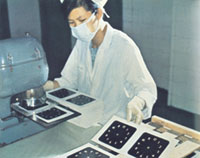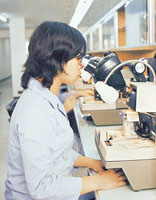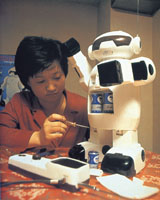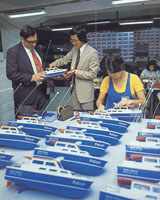| Up-scaling Stage
This stage actually started
in the 1970's and ended in the early 1980's.
In the late 1960's, advanced technology and modern
management skills were introduced to Hong Kong by
European countries and the United States. Hong
Kong under went another structural transformation
changing from a manufacturing base to a diversified
economy.
During this period, Hong Kong's
industry upgraded from labour-intensive towards high
value-adding and technology-intensive direction, due
to the continuous influx of advanced technology.
The contribution of the textile and clothing sector
(labour-intensive industry) to the total domestic
exports was declining, while that of technology-intensive
industries was on the rise. In 1960, there were
only 3 electronics factories in Hong Kong; by 1979,
there had been 1,041 establishments with 90,454 persons
employed. By 1984, Hong Kong had 1,500 factories
in engaged in the manufacture of electronic products.
There was a great variety of electronic products,
including radios, memory units of computer, calculators
and televisions. Components of memory unit made
in Hong Kong had been installed in the internal computer
system of Viking I and II, the U.S. spaceships being
sent to Mars in 1976.
Apart from the above-mentioned,
the toy, watches and clocks industries were also flourishing.
The watches and clocks industry swiftly developed
to be a key industry. In 1976, Hong Kong's total
of export watches and clocks in value terms reached
49.383 million, representing a drastic increase of
45% over 1977. Hong Kong was the world's largest
exporter of watches in terms of quanitty, followed
by Japan; It's exports of watches and clocks ranked
the third largest in terms of value, trailing only
Switzerland and Japan. |
|

Television shows prompted the manufacture
of many space heroes. Yoda from Star Wars was being
packed for shipment to the United States.

Spotless working conditions and stringent
safety precautions ensured the safety of the workforce
and the quality of the finished product. This skilled
operative wore a surgical mask as she operated a machine
to luminise clock faces.

About 50,000
electronic digital watches a month were made completely
in this air-conditioned factory, which also produced
calculators.

Electronic games and toys were making a mark
on the market. Toy with electronic motors accounted
for about 10 per cent of toy exports.

The managing
director of an Australian toy company examined a battery-operated
boat at one of Hong Kong's largest and most modern
toy factories.
|



